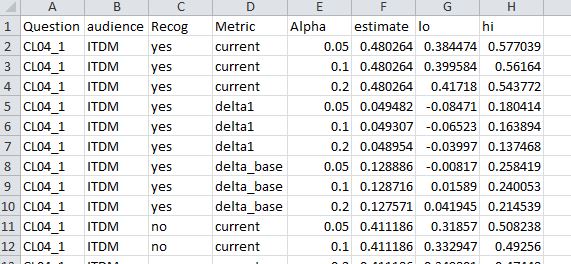Run-time Error 1004: Unable to get the VLookup property of the WorksheetFunction class
Doing a macro in Excel 2010. It opens a workbook, then adds a worksheet from another book that contains several lookup tables set up as named ranges each with workbook scope.
When I get to the For loop and try to invoke Worksheet.Function.VLookup
It's more basic than that. The function doesn't seem to be recognizing the named ranges. Is my syntax for addressing those correct? I've tried Range("Arrays!questionlook
Any ideas? Thanks.
When I get to the For loop and try to invoke Worksheet.Function.VLookup
It's more basic than that. The function doesn't seem to be recognizing the named ranges. Is my syntax for addressing those correct? I've tried Range("Arrays!questionlook
Dim file2open As String
Dim anotherfile2open As String
Dim mainbook As Workbook
Dim rangebook As Workbook
Dim file_name As String
Dim rowz As Integer
Dim colz As Integer
Dim lastrow as integer
Dim question As Integer
Dim audience As Integer
Dim recog As Integer
Dim metric As Integer
Dim measure As Integer
file_name = "sourcedata.csv"
file2open = sourcefolder & "\" & file_name
Set mainbook = Workbooks.Open(Filename:=file2open)
Set datasheet = mainbook.Worksheets(1)
anotherfile2open = sourcefolder & "\" & "lookupranges.xlsx"
Set rangebook = Workbooks.Open(Filename:=anotherfile2open)
rangebook.Worksheets("Arrays").Copy After:=mainbook.Sheets(mainbook.Sheets.Count)
rangebook.Close
datasheet.Activate
lastrow = Cells.Find("*", SearchOrder:=xlByRows, SearchDirection:=xlPrevious).Row
For rowz = 2 To lastrow
' next line is where I get the error
question = WorksheetFunction.VLookup(Cells(rowz, 1), questionlookup, 2, False)
audience = WorksheetFunction.VLookup(Cells(rowz, 2), audiencelookup, 2, False)
recog = WorksheetFunction.VLookup(Cells(rowz, 3), recoglookup, 2, False)
metric = WorksheetFunction.VLookup(Cells(rowz, 4), metriclookup, 2, False)
Data(question, audience, recog, metric, 1) = Cells(rowz, 5)
Data(question, audience, recog, metric, 2) = Cells(rowz, 6)
Data(question, audience, recog, metric, 3) = Cells(rowz, 7)
Data(question, audience, recog, metric, 4) = Cells(rowz, 8)
Next rowzAny ideas? Thanks.
ASKER
Thanks, Thomas.
The formula you put in your response is precisely the same as the manual Vlookup formula I typed, and when entered manually like this it does give me the correct answer.
questionlookup, audiencelookup, recoglookup, and metriclookup are not defined in the macro because they are named ranges, found on the "Arrays" worksheet that I copied into the workbook near the beginning of the macro. They have workbook scope, so should be addressable by name.
That's the heart of my question. Is there something about referring to a named range from within the code that doesn't work the same as referring to a named range from a manually typed formula in a cell? Does the fact that I just brought the "Arrays" sheet into the workbook have anything to do with the fact that the code doesn't recognize the named ranges?
Here's a screenshot of the named ranges on the Arrays sheet. As you can see they are very simple, and the first column is alpha sorted in each case.

Thanks
The formula you put in your response is precisely the same as the manual Vlookup formula I typed, and when entered manually like this it does give me the correct answer.
questionlookup, audiencelookup, recoglookup, and metriclookup are not defined in the macro because they are named ranges, found on the "Arrays" worksheet that I copied into the workbook near the beginning of the macro. They have workbook scope, so should be addressable by name.
That's the heart of my question. Is there something about referring to a named range from within the code that doesn't work the same as referring to a named range from a manually typed formula in a cell? Does the fact that I just brought the "Arrays" sheet into the workbook have anything to do with the fact that the code doesn't recognize the named ranges?
Here's a screenshot of the named ranges on the Arrays sheet. As you can see they are very simple, and the first column is alpha sorted in each case.

Thanks
ASKER CERTIFIED SOLUTION
membership
This solution is only available to members.
To access this solution, you must be a member of Experts Exchange.
In addition to hgholt's very valid point, I still wonder why you'd run a loop to do a vlookup cell by cell?
ASKER
Exactly what I needed! Thanks.
I wasn't aware that you need to bracket named ranges when referring to them in VBA code.
To answer your question, nutsch, each row of my sheet (see image below) has four columns which contain string values that are tied to the numbers in the last 4 columns. So for each row, I first find the equivalent integer for that key. Say, for example, my lookups resolve to 3, 1, 2, 1. Then I store the number in the next column into the array Data (3,1,2,1,1) , then Data (3,1,2,1,2), etc. Later in my routines I'll want to be able to pull up the "lo" value for "Q37_4, ITDM, no, current" and I know it will be stored in Data (3,1,2,1,3)
Can you think of a faster way to do this?

I wasn't aware that you need to bracket named ranges when referring to them in VBA code.
To answer your question, nutsch, each row of my sheet (see image below) has four columns which contain string values that are tied to the numbers in the last 4 columns. So for each row, I first find the equivalent integer for that key. Say, for example, my lookups resolve to 3, 1, 2, 1. Then I store the number in the next column into the array Data (3,1,2,1,1) , then Data (3,1,2,1,2), etc. Later in my routines I'll want to be able to pull up the "lo" value for "Q37_4, ITDM, no, current" and I know it will be stored in Data (3,1,2,1,3)
Can you think of a faster way to do this?
=VLookup(A2, questionlookup, 2, False)
Is that your full code? What is the working manual vlookup formula that gives you the correct answer?
Thomas